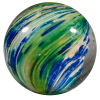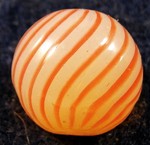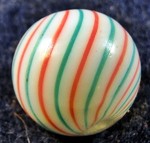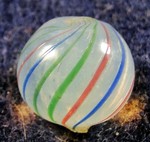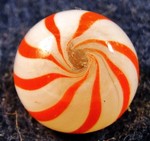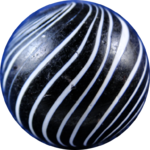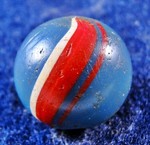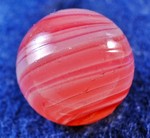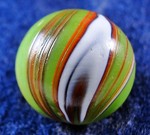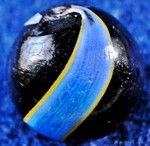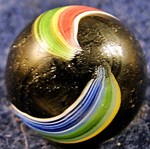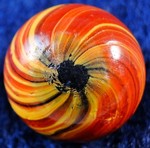CLAMBROTHS, INDIANS, BANDED OPAQUES
A Clambroth is a swirl that has an opaque base with colored strands on the surface. The strands are generally equidistantly spaced.
The base color is usually opaque white. Some opalescent bases have been found. The most common colors for strands are pink, blue or green. A Clambroth
that has strands of more than one color, usually alternating, is called “multicolored”. These are rarer than the single- color marbles. Marbles with a base glass color that is not
white, usually black or blue are also rare. Translucent examples are also rare.
There are two different types of glass that were used for the base glass. One type is relatively hard, like other glass marbles, and does not chip
easily. The other type is very soft and bruises quite easily. Some collectors believe that the hard type is German, while the
soft type is early American, though they could just be different German makers. This does not appear to affect the value of the marble.
Missing strands or poor spacing of the strands results in a discount. Clambroths usually have eight to eighteen strands (depending on the marble size). There are some
Clambroths that have thirty or more strands. These are called “caged” Clambroths and are very rare. There are also Clambroths that are “cased” in a
layer of clear glass. These are also very rare.
Click on any image below to see it full screen.
A Banded Opaque has either an opaque or translucent base glass. The surface of the marble has colored strands, bands or stretched colored flecks on it.
A “swirl-type” banded opaque has colored strands and bands that are unbroken from pole to pole. An “end-of-day-type” banded opaque has bands of stretched colored flecks on the surface. The
stretched flecks generally are not continuous from pole to pole. One type does not seem to be any rarer than the other, but the “swirl-type” are valued slightly higher, probably
because they tend to look better-designed.
Marbles with multi-color bands are rarer, as are marbles with a color base glass, rather than the white base. There are some marbles that have either a brightly colored base or brightly colored
bands. These are sometimes referred to as “electric” and are valued much higher than other banded opaques.
There is a rare type of banded opaque called a “Lightning Strike”. This is a white base marble with several bands around the equator in several colors. The
bands look like lightning bolts.
There are also banded opaques with a base that is satin glass. These are extremely rare.
Click on any marble below for a full-screen image.
An Indian is a banded opaque marble that has an opaque black base. On the surface are bands consisting of colored strands or stretched colored flecks.
A “swirl-type” Indian has colored strands that run unbroken from pole to pole. The bands can be a solid color, or a colored band that consists of subsurface opaque white
strands covered by a transparent color. An “end-of-day-type” Indian has bands of stretched colored flecks that do not run continuously from pole to pole. “Swirl-type” Indians
are about as common as “end-of-day type” Indians, but are valued more highly, probably because they appear to the eye to be better designed and have more eye appeal.
The surface usually has two bands on it. Multi-band examples are rarer and command a premium. Generally, the more surface area that is covered by color, the more valuable the
marble. Indians that are completely covered by color are called “360 Indians” (360 degrees).
There are marbles with a translucent dark red or dark amethyst base glass. These are called “mag-lites” and carry a premium. Blue, green or amber translucents are much
rarer.
Click on any marble below to see a full-screen image.


